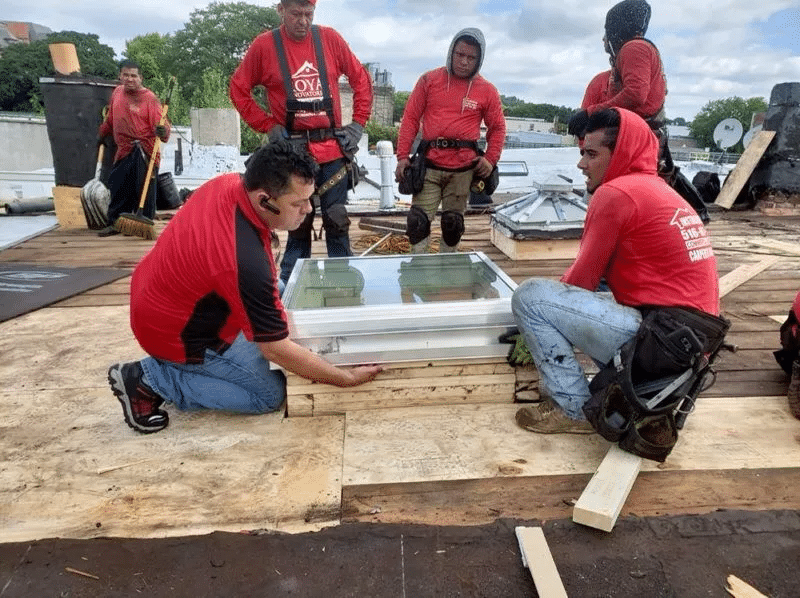How to Choose the Right Roof for Your Tiny Home: 8 Key Considerations

When it comes to tiny homes, every detail matters and the roof is no exception. As a leading provider of quality roofing services, we understand the unique challenges and opportunities that come with selecting the perfect roof for your compact dwelling. With years of experience and a deep understanding of tiny home architecture, we’re here to guide you through this crucial decision. We’ll walk you through eight essential factors to consider when choosing the right roof for your tiny home, ensuring you make an informed decision that you’ll be happy with for years to come.
-
Weight Considerations
One of the most critical factors in choosing a roof for your tiny home is weight. Due to their ease of mobility, tiny houses are frequently constructed on trailers. This mobility comes with weight restrictions that directly impact your roofing choices.
- Lightweight Materials: Consider materials like metal roofing, which is not only lightweight but also durable. Aluminum and steel are popular choices that won’t overstress your tiny home’s structure.
- Structural Integrity: Your home’s frame must be able to handle your roofing material weight. This may require consulting with a structural engineer or experienced tiny home builder.
-
Weather Resistance
Your tiny home’s roof shields it from the weather and keeps it secure. Depending on your location and climate, you’ll need to choose a roofing material that can withstand various weather conditions.
- Rain and Moisture: In areas with high rainfall, consider materials with excellent water-shedding properties like metal roofing or specially designed rubber roofing membranes.
- Snow Load: If you live in snowy areas, ensure your roof can handle snow buildup. Snow sheds more effectively on a steeper pitch.
- Wind Resistance: For areas prone to high winds or storms, look for roofing materials and designs that offer superior wind uplift resistance.
-
Energy Efficiency
Energy efficiency is crucial in tiny homes, where every bit of space and resource counts. A home’s ability to control energy use and maintain efficiency is greatly influenced by its roof.
- Insulation: Keeping your tiny home at a comfortable temperature requires adequate insulation on the roof. Consider materials with high R-values or incorporate additional insulation layers.
- Reflective Surfaces: Cool roofing materials with high solar reflectance can significantly reduce heat absorption, keeping your tiny home cooler in summer and reducing air conditioning costs.
- Ventilation: Good roof ventilation keeps temperature and moisture levels in check. Consider incorporating ridge vents or other ventilation systems to improve air circulation.
-
Aesthetics and Design
While functionality is paramount, the aesthetic appeal of your tiny home’s roof shouldn’t be overlooked. Your home’s roof affects the way it looks and feels overall because it frequently makes up a large amount of the exterior that is visible.
- Architectural Style: Choose a roofing material and design that complements your tiny home’s architectural style. For example, a metal roof might suit a modern, minimalist design, while shingles could work well with a more traditional look.
- Color Choices: Pay attention to the color of your roof because it can affect performance. Whereas darker colors absorb heat, lighter colors reflect more light.
- Texture and Finish: Consider how different textures and finishes will look on your tiny home. Smooth, glossy finishes can create a sleek appearance, while textured materials add depth and character.
-
Durability and Lifespan
Investing in a durable roof with a long lifespan is especially important for tiny homes, where replacement can be more challenging and disruptive than in traditional houses.
- Material Longevity: Look into how long various roofing materials are expected to last. Even if certain options can cost more up front, over time they might end up being more cost-effective.
- Maintenance Requirements: Consider how much maintenance different roofing materials require. Selecting low-maintenance materials results in cost and time savings.
- Warranty: Look for roofing materials that come with comprehensive warranties to protect your investment.
-
Cost Considerations
Every choice you make about home remodeling, including roofing for tiny homes, is influenced by your budget. Balance long-term value with upfront costs.
- Material Costs: Compare the costs of different roofing materials, keeping in mind that prices can vary based on quality and brand.
- Installation Expenses: Some materials are more labor-intensive to install than others, which can impact overall costs. DIY-friendly options might save money if you have the skills.
- Resale Value: If you plan to sell your tiny home in the future, a high-quality roof can be a selling point and potentially increase your home’s value.
-
Local Regulations and Building Codes
Navigating the regulatory landscape can be challenging for tiny homes, especially when it comes to roofing.It is vital that the roofing material you select adheres to building rules and local ordinances.
- Zoning Laws: Check local zoning laws to ensure your tiny home and its roof meet all requirements, especially if you plan to park it permanently.
- Building Codes: Familiarize yourself with local building codes that may dictate aspects of your roof, such as minimum slope requirements or fire-resistance ratings.
- Permitting: Determine permissibility for your roofing project, even if you’re building a mobile tiny home.
-
Environmental Impact
As tiny homes often appeal to environmentally conscious individuals, considering the ecological footprint of your roofing choice is important.
- Recyclable Materials: Look for roofing materials that can be recycled at the end of their lifespan, reducing waste sent to landfills.
- Sustainable Production: You must consider the effects that various roofing materials have on the environment. Certain materials can be manufactured with minimal energy or carbon footprint.
- Local Sourcing: Choosing locally sourced materials can reduce transportation emissions and support your local economy.
Conclusion
Selecting the right roof for your tiny home involves balancing numerous factors, from weight and weather resistance to aesthetics and environmental impact.
By hiring an experienced roofing contractor at 118-35 Queens Blvd Forest Hills, NY 11375 (718) 414-6067 nycrenovators.com, homeowners can have peace of mind, assured that they have a protected home as their haven.
